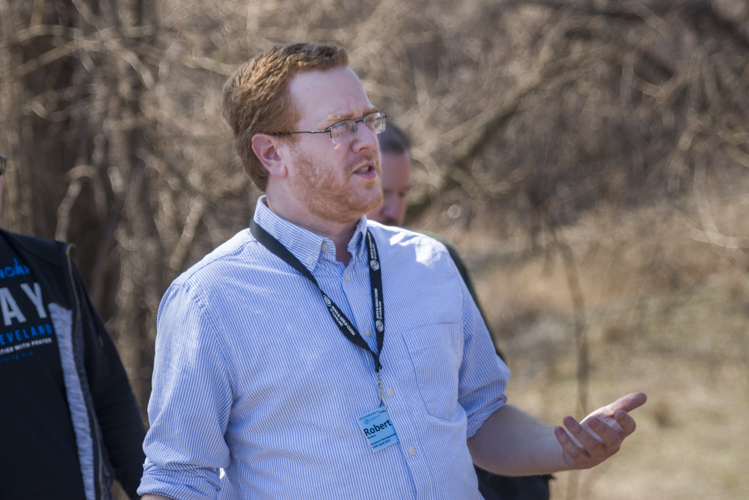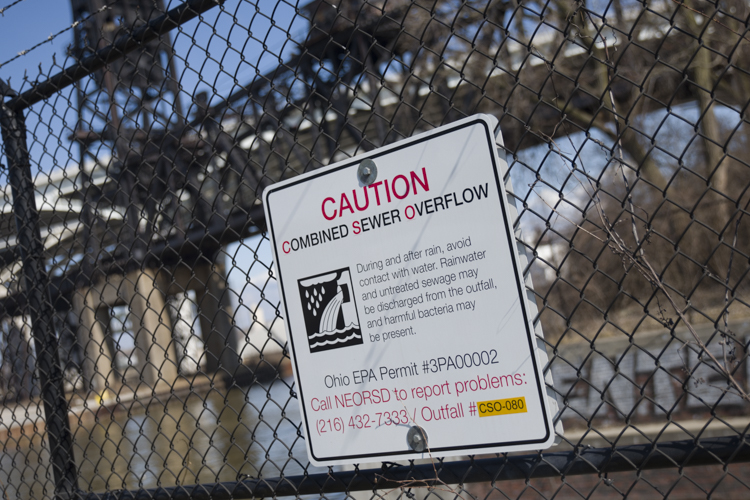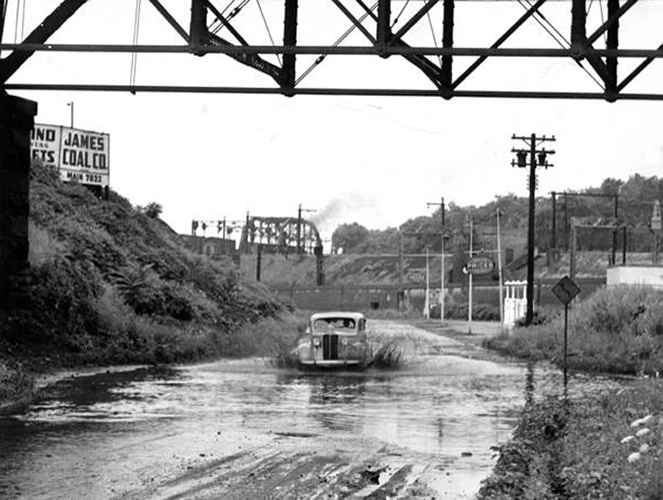Archeologist reveals evidence of the hidden waterways of the Cuyahoga Delta
Not surprisingly, Cleveland’s geological landscape 200 years ago was quite different than today’s modern, industrialized city. In 1820, spring-fed streams ran freely throughout the region, running through neighborhoods like Cleveland Heights, Kinsman, Scranton Flats, and Ohio City.
Last Saturday, April 6, these now-hidden waterways took the spotlight during a sold-out tour, Exploring Cleveland’s Hidden Waterways. Led by Paleolithic archaeologist Roy Larick, the tour began and ended at the Cleveland History Center as part of Cleveland Humanities Festival. Tourists made six stops via bus at parts of Kingsbury Run, Morgana Bluffs, Walworth Run, and Giddings Run.
Larick is already planning similar tours for the future (likely later this year), which is good because he's got plenty to say on the topic.
“The interesting thing about these streams is that, at one time, they all had spring water,” shares Larick, founder of Bluestone Heights and a paleolithic archeologist with a focus on Cleveland’s geological history. “You could drink out of [the streams], and they were used for brewing, wash water, kerosene refining, and slaughtering.”
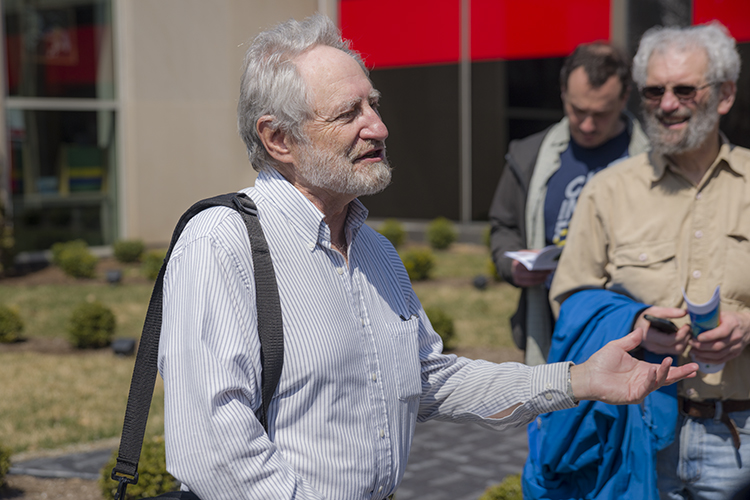 Paleolithic archaeologist Roy LarickThese streams easily cut through the gravel that makes up the Cuyahoga delta, cutting into the region’s landscape. “The stream could excavate quickly and form an ecologically diverse channel,” Larick explains. “The thing that people will be impressed by is how many ravines are 50 to 60 feet deep and 100 yards wide and have been filled with rubble from construction debris."
Paleolithic archaeologist Roy LarickThese streams easily cut through the gravel that makes up the Cuyahoga delta, cutting into the region’s landscape. “The stream could excavate quickly and form an ecologically diverse channel,” Larick explains. “The thing that people will be impressed by is how many ravines are 50 to 60 feet deep and 100 yards wide and have been filled with rubble from construction debris."
Cleveland’s early industry settled along these streams, and portions of the waterways were buried to level and build on the land. By 1900, the streams had become polluted from such activity. These waterways were further buried and became a part of the storm sewer system.
Today, as Cleveland celebrates the precedents set and improvements made to the Cuyahoga River and Lake Erie 50 years after the river caught on fire, these buried waterways that once made up 60 miles of open streams continue to suffer.
Once areas that Cleveland’s early residents gravitated toward, large gorges and ravines mark where these hidden delta springs still flow deep underground. On the tour, Larick led the tourists through the history of each of the six sites and talked about hope that these spaces can perhaps one day be salvaged for greenspace.
“Restoring is best as a slow and cumulative process tied with [both] green stormwater infrastructure and local park development,” he says. He notes Northeast Ohio Regional Sewer District's efforts to transform some of the land into parks through Project Clean Lake (such as the Woodland Central Green Infrastructure project at 6401 Kinsman Road, and the project on Buckeye Road, where Woodhill Road and Shaker Boulevard meet).
Stops on the tour that illustrate success stories in restoring these ghost streams included Kingsbury Run in the Kinsman neighborhood, where tour participants stopped at Sidaway Bridge (6902 Berwick Road) and Morgana Bluffs, where the former Worsted Mills site is being transformed into Morgana Bluffs Nature Preserve. At the former, Emily Thompson of Burten Bell Carr Development talked about the project, while at the latter, Robert Koonce, chief development officer for the Boys and Girls Clubs of Cleveland, spoke about the benefits of the forthcoming Morgana Bluffs.
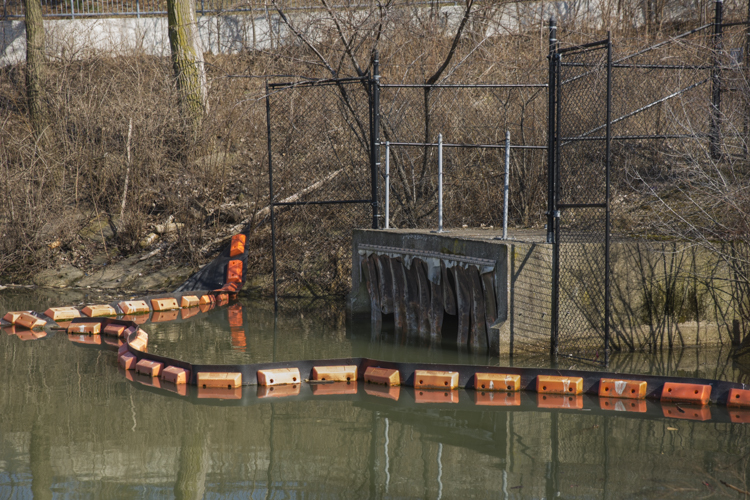 Larick also cites Walworth Run, which now hosts the W. 65th Street Rapid station and used to be home to a railroad, as another stunning example of one of Cleveland’s hidden waterways.
Larick also cites Walworth Run, which now hosts the W. 65th Street Rapid station and used to be home to a railroad, as another stunning example of one of Cleveland’s hidden waterways.
Larick says he hopes these tours will give Clevelanders a new perspective on the city’s ghosted waterways and provide hope that they all can one day be restored.
“Many of the streams will never be daylighted, at least in my conception in my lifetime—they are too deeply buried,” he says. “Nevertheless, in time the culverts will fail to the point of needing replacement. If the technology is not yet developed to replace them from below, they will be dug up.”
But Larick warns there is a lot of work to be done before any real change can occur. “At that point, decisions can be made about leaving them open—or at least the ravines open,” he says. “For now, the sewers are still too dirty to open up.”
Click here for a list of the tour locations.







